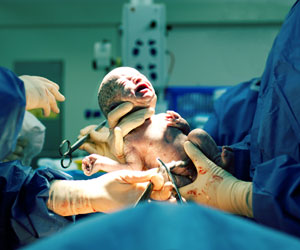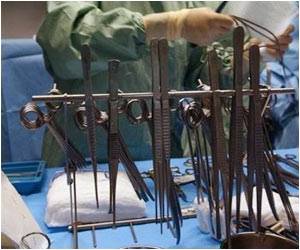- Approximately 1.3 million children or one in every three babies are being delivered by Cesarean section each year.
- Researchers estimate that in over 50% of instances when C-sections are performed in the U.S.A., the babies could be safely delivered vaginally.
- Cesarean awareness month highlights the increasing Cesarean cases, and promotes vaginal birth wherever possible.
Cesarean or C-section Delivery
Delivery of a baby through an incision in the mother’s abdomen is known as cesarean or a C-section. It is a surgical method of delivering a baby, undertaken when normal vaginal delivery is not possible or risky for the mother or baby. The Latin word ‘cedere' means ‘to cut', from which ‘Cesarean’ might have originated. 'Cesarean section' means to 'cut out'.Global Numbers of Cesarean Deliveries
C-section is the most commonly performed surgery in the U.S.A., and approximately 1.3 million children each year or one in every three babies are being delivered by surgery.- In a survey done considering data between 1990-2014, Latin America and the Caribbean region has the highest CS rates (40.5%), followed by Northern America (32.3%).
- The global average CS rate increased 12.4% (from 6.7% to 19.1%) with an average annual rate of increase of 4.4%.
- Not only in developed countries but also in developing nations such as Asia 15.1%, (from 4.4% to 19.5%) and 4.5% in Africa (from 2.9% to 7.4%), CS rates have gone up.
- Asia had the highest annual increase of 6.4%.
- On the other extreme, Africa had the smallest absolute rise (4.5%) and remained as the region with the lowest CS rates
Why C-section?
Cesarean section was initially done when pregnant mothers died due to illness. The baby was removed from the mother’s womb. Later it was also done when the mother was alive; in cases of breech position, low levels of amniotic fluid, failure to labor.There are personal preferences and decisions that call for a C-Section. Various repeated reasons in many studies are:
- fear of pain or labor
- concerns about genital modifications after vaginal delivery
- safety of the baby: misconception that CS is safer for the baby
- availability of doctors/specialists: the convenience for health professionals and also for the mother and family
- lower tolerance to any complications or outcomes
Why Not a C-Section?
In middle and high income countries, the use of CS has increased despite the lack of evidence supporting maternal and paternal benefits and some studies showing a link between increasing CS rates and poorer outcomes.A study done using data collected from 26 countries found that no significant differences existed in maternal mortality or serious maternal morbidity between planned cesarean section and planned vaginal birth for breech presentation.
WHO global survey on maternal and perinatal health in Latin America, in fact, revealed that the rate of cesarean delivery was positively associated with postpartum antibiotic treatment referring to the infection after surgery, severe maternal and neonatal morbidity, and maternal and fetal death.
Compared to planned vaginal delivery and unplanned CS, planned cesarean delivery was associated with
- an increased risk of infection, anesthetic complications and placenta previa (discharge of placenta before the baby is delivered)
- risk of complications in subsequent pregnancies
- longer hospital stay of mothers and neonates
- higher risk of respiratory morbidity for infants
Bottomline
The Cesarean awareness month calls for reducing the number of unnecessary C-sections and promote vaginal birth after C-section which can be achieved with the guidance and support of health care providers.Reference:
- Caesarean section delivery in India: causes and concerns - (https://iussp.org/sites/default/files/event_call_for_papers/Caesarean%20section%20delivery%20in%20India_0.pdf)
- The Increasing Trend in Caesarean Section Rates: Global, Regional and National Estimates: 1990-2014 - (https://www.ncbi.nlm.nih.gov/pmc/articles/PMC4743929/)










